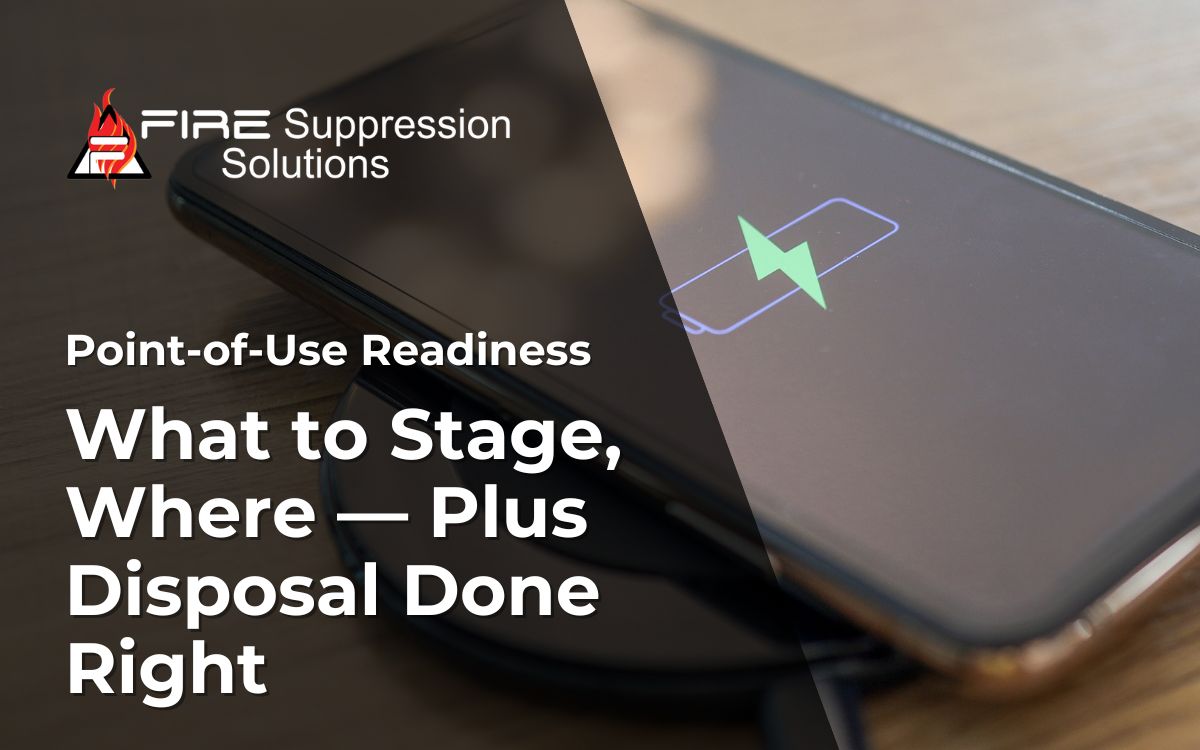Improvising during a lithium-ion battery incident costs time. Readiness beats reaction. If tools, signs, and simple routines live where charging happens, people act faster and safer. This guide shows what to stage, where to put it, and how to handle batteries at end-of-life so your home, school, or business stays ahead of the problem.
Why this matters: Lithium-ion fires are not ordinary fires. They’re driven by a self-sustaining chemical chain reaction (thermal runaway), burn hotter, and can re-ignite if not extinguished properly. Traditional (ABC) dry-chemical extinguishers do not work on lithium-ion battery fires because they don’t stop the reaction.
What “point-of-use” really means
If you have to hunt for a tool, it’s not ready. Point-of-use means the essentials are within arm’s reach of charging areas, labeled, and obvious to anyone walking up — no guessing, no keyholder required.
The core kit (most locations)
- Clear instructions extinguish if possible — Hands off • Close the door • Evacuate/911
- Lithium-ion-extinguisher (TRF+ certified fluid, StaySafe )
- Listed (UL/ETL) power strip for the area; no daisy-chains
- Unplug reminder (sticker or small placard)
- Cool, dry storage bin for spare batteries (not on soft surfaces)
(If you’re in a workplace, add your overnight shutdown card and the name/number of the person who can lock out a problematic area.)
Where to stage it (by setting)
Home & Apartments
- Best spots: kitchen counter away from fabrics, home office desk, garage charging table, e-bike/scooter area on a hard, flat, uncovered surface.
- Rule for renters: In-unit charging only; keep exits clear; unplug when full.
Skip these: beds, sofas, carpet, hallways, and doorways. No hallway charging in multi-unit buildings.
Classrooms & Libraries
- Tables/stations only—not in aisles or doorways.
- Post a student-friendly rules sign at eye level.
- Keep the Extinguisher where staff can reach it (per district policy).
- Carts: cords routed in channels; unplug when full; secure overnight.
Small habits that add up: label the correct charger for each cart/device set and replace any power strip that feels warm or loose.
Offices, Breakrooms, Copy/IT Rooms
- One UL listed power strip per outlet. Do not daisy chain power strips.
- Overnight shutdown card on the fridge or exit door: unplug, clear surfaces, close door.
- Stage the extinguisher at the room entrance and mount the incident steps at eye level.
Red flags: cords across exits; strips tucked under paper stacks; chargers that “always feel warm.”
Warehouses, Shipping, Service Bays
- Designate a charging zone on non-combustible surfaces, outside egress paths.
- Stage the extinguisher on the approach to the zone; incident steps sign at the entry.
- Create an isolation plan: if a device vents, close the door and clear the aisle.
Quick check: replace any power strip with loose sockets, discoloration, or scorch marks—today, not “someday.”
First Responders — Stations, Dispatch, Apparatus, Field
- Station charging zones: hard, flat, uncovered tables, listed strips, no daisy chains, egress kept clear.
- Dispatch and radio rooms: stage a lithium-ion–certified extinguisher such as TRF+ at the entry, post incident steps at eye level, keep tape and small bags for terminal taping and bagging loose cells, post local drop-off info.
- Apparatus: carry a portable StaySafe device in the cab or EMS bag, stage a TRF+ 6-Litre in a compartment near hand tools, verify a water supply for cooling when policy allows.
- Shops and back rooms: mark a charging zone, place the extinguisher on approach, keep aisles open, add a simple door-control plan for isolation.
- Community work: bring renter and small-business handouts, reinforce in-unit charging only and clear exits, use a QR code sign to your resources.
Two routines that keep you ready
The two-minute daily walk-by
- Are devices on hard, flat, uncovered surfaces?
- Are exits clear and cords tidy/low?
- Any warm or loose strips to replace?
The five-minute weekly reset
- Verify listed chargers/strips; remove any look-alikes.
- Re-post the incident steps where they’ve drifted.
- Seal the tape/bag kit for battery drop-off.
If you see heat, odor, swelling, hissing, or smoke: Hands off • Close the door • Evacuate • Call 911. Do not carry a smoking device outside. If equipped and it’s safe, use a certified extinguishing agent (TRF+ fluid “StaySafe”).
Disposal done right
1) Never in the trash.
Lithium-ion batteries do not go in household trash or recycling.
2) Prep them safely.
For loose cells or small packs: tape the terminals and place each in a bag to prevent contact. Store cool and dry until drop-off.
3) Use a drop-off.
Take batteries and damaged devices to an appropriate battery collection site or household hazardous waste program in your area.
4) After damage or water exposure.
If a device was flooded, crushed, or punctured, do not recharge it. Treat it as end-of-life and take it to drop-off following the same tape/bag steps.
5) After an incident.
Assume re-ignition risk until responders clear the area. Do not reuse the device. Coordinate proper disposal; ventilate only when safe and permitted by responders.
Put it all together
Readiness isn’t complicated: stage the kit where you charge, keep exits clear, follow the two-minute/ five-minute checks, and handle end-of-life with tape, bag, drop-off. The same pattern works at home, in schools, and across workplaces—and it keeps everyone using the same language: buy smart, charge smart, recycle right.
Keep going: Explore our Fire Prevention Week Resource Hub (free downloads) for clear incident steps, rules signage, overnight shutdowns, renter guidance, and more you can use alongside the staging plan above.
Safety note: Always follow manufacturer instructions, local policy, and on-scene directions from first responders.

